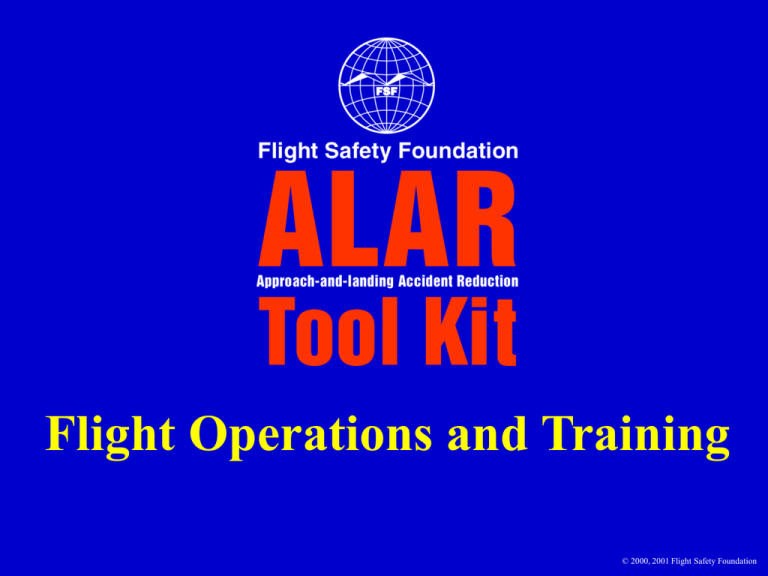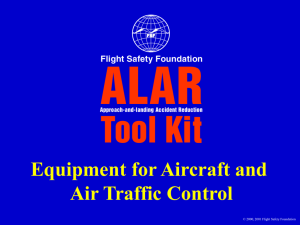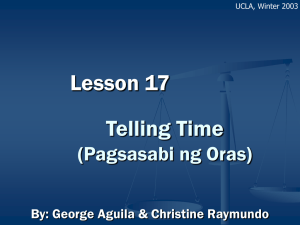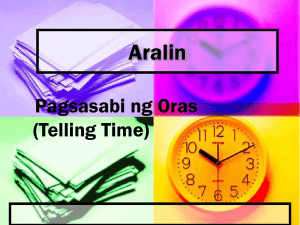Flight Operations and Training
advertisement

Flight Operations and Training © 2000, 2001 Flight Safety Foundation CFIT and ALAR Task Forces Flight Safety Foundation Steering Committee and Working Groups CFIT ALAR Flight Safety Foundation ALAR Task Force Organization Steering Committee Data Acquisition and Analysis Working Group Operations and Training Working Group FSF CFIT/ALAR Action Group (CAAG) Air Traffic Control Training and Procedures/ Airport Facilities Working Group Aircraft Equipment Working Group Approximately 125 aviation safety specialists are involved worldwide. ALAR Objectives • To reduce the approach-and-landing accident (ALA) rate by 50% within 5 years of issuing final recommendations in 1999. • To identify equipment, operational, regulatory and training measures that will improve safety for aircraft from commencement of approach through circling, landing or missed approach. Statistics for Approach-and-landing Accidents (ALAs) • 56% of Western-built large commercial jet accidents are ALAs. • Approximately 50% of fatalities are the result of Western-built large commercial jet ALAs. • By 2010, the task force estimates 23 Western-built large commercial jet fatal accidents will occur annually. • Controlled-flight-into-terrain (CFIT) accidents are not showing a downward trend. ALAR Data-driven Strategy • High-level analyses of 287 accidents • In-depth study of 76 incidents and accidents • Line observations on 3,300 U.S. flights • All conclusions supported by data Inadequate Situational Awareness in ALAs • Inadequate situational awareness was a factor in 51% of ALAs. • Currently available safety equipment was not installed in 29% of the aircraft in ALAs. Food for Thought: The captain was the pilot flying in 74% of ALAs involving dual-pilot operations. From the Outer Marker To the Landing 4% of flying time results in 45% of hull-loss accidents involving Western-built large commercial jets. Most Common Types of Approach-and-landing Accidents • CFIT • Loss of control • Landing overrun • Runway excursion • Unstabilized approach These comprised 76 percent of the sample. Missed Approach • Failure to recognize the need for a missed approach and to execute a missed approach is a major cause of ALAs. • Companies should declare and support no-fault go-around policies. Photo by Dr. David Powell Factors in Unstabilized Approaches and Missed Approaches • 42% involved “press-on-itis.” • 36% were low and/or slow on approach. • 30% were high and/or fast on approach. • Only 17% of crews initiated go-arounds. Unstabilized Approaches • Unstabilized approaches contribute to ALAs. • Operators should define the parameters of a stabilized approach in their flight operations manuals. • Operator policy should state that a go-around is required if the approach becomes unstabilized below the minimum stabilization height. • The implementation of certified constant-angle, stabilized-approach procedures for nonprecision approaches should be expedited globally. Minimum Stabilization Height The approach should be stabilized by 1,000 feet in IMC, 500 feet in VMC. IMC = Instrument meteorological conditions VMC = Visual meteorological conditions Recommended Elements of a Stabilized Approach 1. The aircraft is on the correct flight path; 2. Only small changes in heading/pitch are required to maintain the correct flight path; 3. The aircraft speed is not more than VREF + 20 knots indicated airspeed and not less than VREF; 4. The aircraft is in the correct landing configuration; (continued) Recommended Elements of a Stabilized Approach (continued, #2) 5. Sink rate is no greater than 1,000 feet per minute; if an approach requires a sink rate greater than 1,000 feet per minute, a special briefing should be conducted; 6. Power setting is appropriate for the aircraft configuration and is not below the minimum power for approach as defined by the aircraft operating manual; 7. All briefings and checklists have been conducted; (continued) Recommended Elements of a Stabilized Approach (continued, #3) 8. Specific types of approaches are stabilized if they also fulfill the following: instrument landing system (ILS) approaches must be flown within one dot of the glideslope and localizer; a Category II or Category III ILS approach must be flown within the expanded localizer band; during a circling approach, wings should be level on final when the aircraft reaches 300 feet above airport elevation; and, 9. Unique approach procedures or abnormal conditions requiring a deviation from the above elements of a stabilized approach require a special briefing. Photo by Jan Ovind CRM, SOPs and Training Factors Involved in ALAs • 74% - Inadequate crew decision making • 72% - Inadvertent nonadherence to procedures • 63% - Failure in CRM (cross-check/coordination) • 46% - Failures in company management • 40% - Deliberate nonadherence to procedures • 37% - Inadequate training CRM = Crew resource management SOPs = Standard operating procedures Standard Operating Procedures • Establishing and adhering to adequate SOPs and flight crew decision-making processes improves approach-and-landing safety. • States should mandate, and operators should develop and implement, SOPs for approach and landing operations. • Operators should implement routine and critical evaluation of SOPs to determine the need for change. • Operators should provide education and training that enhance flight crew decision making and risk management. Communication Factors • 33% of the ALAs and serious incidents involved incorrect or inadequate ATC instruction/advice/service. Pilot-Controller Communication • Improving communication and mutual understanding between controllers and pilots of each other’s operational environment will improve approach-and-landing safety. Terminal Area Infrastructure • 21% of ALAs involved lack of ground aids. • 12% of ALAs involved lack of ATC equipment (terminal approach radar, minimum safe altitude warning). • The risk of ALAs during nonprecision approaches is five times greater than the risk of ALAs during precision approaches. • The risk of ALAs in the absence of terminal approach radar is three times greater than the risk of ALAs with terminal approach radar available. (continued) Terminal Area Infrastructure (continued, #2) • Precision approach capability and approach radar reduce the risk of ALAs. • Encourage crews to use more precise approach guidance at all times such as ILS, GNSS, PAPI and VASI. • Develop precision approach capability to all runways by application of technology (e.g., GNSS and LAAS). • Implement MSAW or equivalent on all approach radars for ATC terrain warning. GNSS = Global navigation satellite system PAPI = Precision approach path indicator VASI = Visual approach slope indicator LAAS = Low altitude alert system MSAW = Minimum safe altitude warning system Environment • 59% of ALAs involved poor visibility. • 21% of ALAs involved disorientation/visual illusion. • 18% of ALAs involved runway condition: – • 73% of ALAs involved overruns on contaminated runways. 37% of ALAs involved precipitation/winds. (continued) Environment (continued, #2) • The risk of ALAs is higher in operations conducted in low light and poor visibility, on wet or otherwise contaminated runways, and with the presence of visual or physiological illusions. • Flight crews should be trained in operations involving these conditions before they are assigned line duties. • Flight crews should make operational use of a riskassessment tool to identify approach and landing hazards. Appropriate procedures should be implemented to reduce the risks. Safety Data Monitoring Programs • Through the collection and analysis of in-flight parameters, FOQA programs identify performance trends that can be used to improve approach-and-landing safety. • FOQA should be implemented worldwide in concert with information-sharing partnerships such as GAIN, BASIS and ASAP. • Provision should be made on aircraft for equipment to support data collection and analysis. FOQA = Flight operational quality assurance GAIN = Global Aviation Information Network BASIS = British Airways Safety Information Service ASAP = U.S. Federal Aviation Administration Aviation Safety Action Program Aviation Safety Information • Global sharing of aviation information decreases the risk of ALAs. • FOQA data must be de-identified. • Public awareness of the importance of information sharing must be increased. • Airlines and regions that share information have the lowest accident rates. • Crews that are aware of an accident and its causes are less likely to repeat that type of accident. FOQA = Flight operational quality assurance (program) ALAR Tool Kit • • • • • • • • • • • • • • • • • • • Flight Safety Digest: “ALAR Briefing Notes” Flight Safety Digest: “Killers in Aviation: FSF Task Force Presents Facts About Approach-and-landing and Controlled-flight-into-terrain Accidents” FSF ALAR Task Force Conclusions and Recommendations FSF ALAR Task Force Members Selected FSF Publications Approach-and-landing Risk Awareness Tool Approach-and-landing Risk Reduction Guide Standard Operating Procedures Template ALAR Information Posters CFIT Checklist CFIT Alert Flight Operations and Training Equipment for Aircraft and Air Traffic Control Air Traffic Control Communication Pilot Guide to Preventing CFIT Approach-and-landing Accident Data Overview An Approach and Landing Accident: It Could Happen to You CFIT Awareness and Prevention Links to Aviation Statistics on the Internet More information? Flight Safety Foundation Suite 300, 601 Madison Street Alexandria, VA 22314-1756 U.S. Telephone: +1 (703) 739-6700 Fax: +1 (703) 739-6708 www.flightsafety.org This is a self-contained product of the Flight Safety Foundation Approach-and-landing Accident Reduction (ALAR) Task Force and includes a variety of information to help prevent approach-and-landing accidents, including those involving controlled flight into terrain (CFIT). This information is not intended to supersede operators’/manufacturers’ policies, practices or requirements, or to supersede government regulations. In the interest of aviation safety, the contents of the FSF ALAR Tool Kit may be displayed, printed, photocopied and/or distributed on paper for noncommercial use. Except as specifically permitted above, the contents must not be offered for sale directly or indirectly, used commercially, distributed on the Internet and/or on any other electronic media without the prior written permission of Flight Safety Foundation. All uses of the FSF ALAR Tool Kit must credit Flight Safety Foundation. Contact Roger Rozelle, director of publications, for more information. © 2000, 2001 Flight Safety Foundation (official release v. 3.0) Flight Safety Foundation Suite 300, 601 Madison Street, Alexandria, Virginia 22314-1756 U.S. Telephone: +1 (703) 739-6700; Fax: +1 (703) 739-6708 http://www.flightsafety.org








